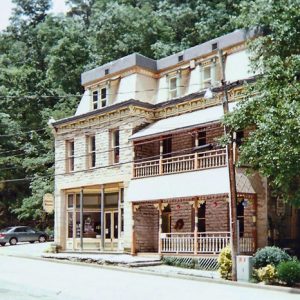calsfoundation@cals.org
Eureka Springs Historical Museum
The Eureka Springs Historical Museum is located in the 1889 Calif Building. Its mission is to collect, preserve, and exhibit the documents, photographs, and artifacts pertaining to the history of Eureka Springs (Carroll County) and the surrounding area.
In 1971, the Ozark Folk Festival Board of Directors purchased the historic Calif Building for the purpose of establishing a museum of local history. A museum advisory board accepted the task to collect, preserve, and exhibit artifacts in the building. The museum opened to the public in October 1971. In 1980, the Eureka Springs Historical Museum, Inc., an association whose membership is open to all interested persons, assumed ownership of the museum property and oversight of its operation. The wood and glass storefront and two-story ornamental wood porches were subsequently replaced as the building was restored to its original appearance. Aside from photographs and exhibits devoted to historical Eureka Springs, the museum includes a replica early twentieth-century parlor that can be reserved for events. The upstairs of the museum is an art gallery devoted to the various artists who have worked in Eureka Springs, including Louis and Elsie Freund.
The museum’s income is derived from admissions, donations, fundraisers, research fees, and gift shop sales, as well as memberships. It is open from 9:30 a.m. to 4 p.m. Monday through Saturday, and 11:00 a.m. to 4:00 p.m. Sunday.
For additional information:
Eureka Springs Historical Museum. http://www.eurekaspringshistoricalmuseum.org/ (accessed January 31, 2022).
Powell, Brittany. “Museum Watch: Lace Curtains in a Hardscrabble Hill Town.” Arkansas Democrat-Gazette, June 15, 2010, p. E1.
Carol Greer
Eureka Springs Historical Museum
 Eureka Springs Historical Museum
Eureka Springs Historical Museum 




While visiting Eureka Springs and the museum there, we were told this story about the only bank robbery in the towns history and shown photos of the culprits bodies in the museum’s collection. During the heyday of Bonnie and Clyde, John Dillinger, and other outlaws of the Depression era, four men robbed a bank in Eureka Springs. While making their escape down the unfamiliar, narrow, and twisting roads with police in hot pursuit, they crashed. In the ensuing shootout, all four men were killed. As was the custom of the day, photos of the four were taken as they lay in the morgue and displayed publicly. Three of the robbers were known to authorities in Oklahoma and Texas, but the fourth man was never identified. Nearly fifty years later, as a group was walking through the newly opened museum, an elderly woman began to gasp and cry at the sight of a picture on display. It seems her brother had left home with three friends back in the thirties and was never heard from again. The nameless bandit was indeed her long-lost brother and the half-century-old mystery of his disappearance was finally solved. I’ve always found this story touching and interesting as an odd and unintentional benefit of the museums collection.